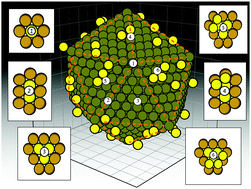Structural surface and thermodynamics analysis of nanoparticles with defects†
Abstract
In this work, we analyze the surface structure and thermodynamics regarding the decoration of nanoparticles with defects, using statistical calculations and Monte Carlo simulations in a complementary way. The main objective is to design and analyze a simple model as a general tool that can help the interpretation of results from more specific and complex models. In particular, we show how the presence of surface defects of the same nature as the nanoparticle induces different site distributions depending on different factors such as the density of defects, and the geometry and size of the considered nanoparticle. These distributions are analyzed for icosahedron nanoparticles of different sizes and densities of defects, and then are linked with Monte Carlo simulations to interpret the thermodynamic effects of the modified surfaces. Under low temperature or strong attractive interaction conditions, the details emerging from the defective surfaces were manifested as wide plateaus in the isotherm and peaks in the compressibility of the adlayer. Different situations were observed as the temperature increases, since the structural details gradually disappear from the thermodynamic measurements, until plateaus and compressibility peaks completely merge under high enough temperature conditions. Adsorption site distribution, adsorption isotherms, energy per site, compressibility of the adlayer, and other relevant properties are analyzed as a function of the number of defects and the chemical potential. In addition to the icosahedron, cuboctahedron and truncated octahedron geometries are also analyzed.



 Please wait while we load your content...
Please wait while we load your content...